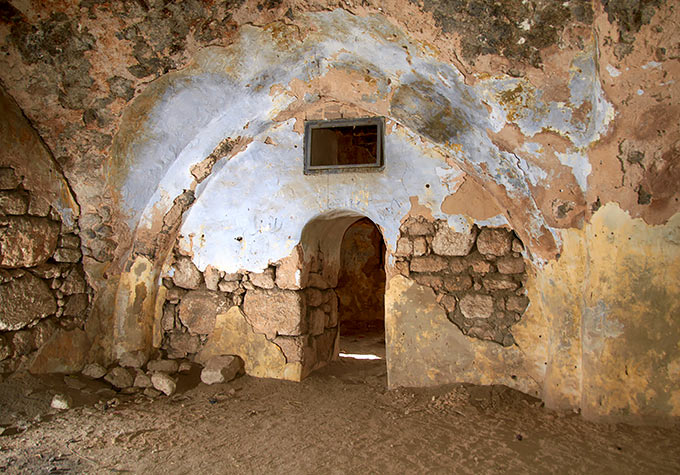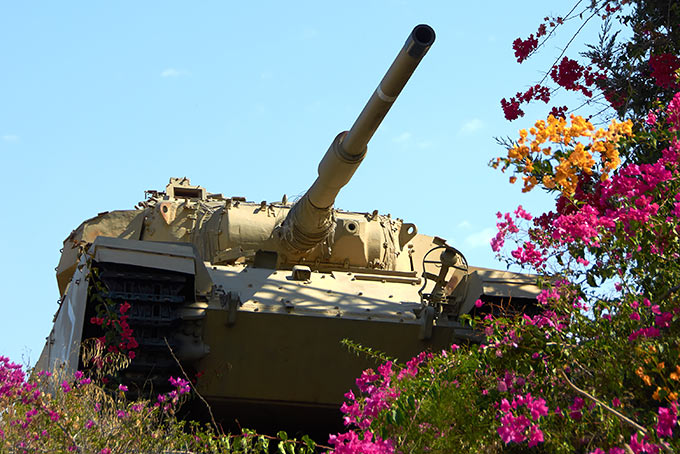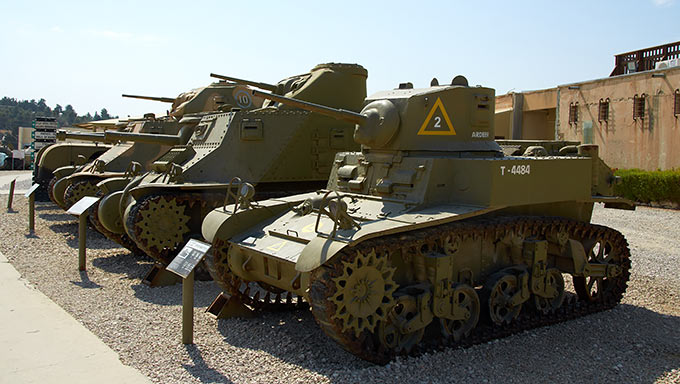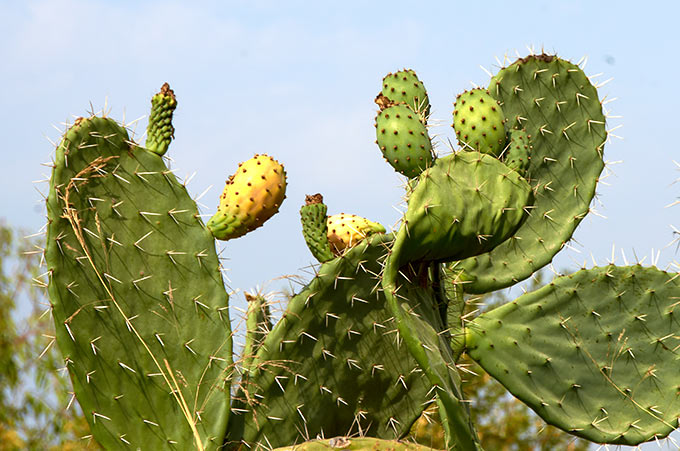Fort Latrun
Latrun (Hebrew: לטרון, in Arabic: اللطرون) is a hill near to the important highway Jerusalem-Tel Aviv at the entrance to the valley of Ayalon. The place has a great strategic importance, because possibility to control the communication between the Dead Sea and the Mediterranean coast. There are two versions of the origin of the name of Latrun: the first says that it distorted the French 'Le toron des chevaliers', ie 'Tower of Knight' and refers to the era of the Crusaders, the second version says that the name came from the pilgrims in the 14th century and has its origin from the Latin 'Domus boni Latronis' or 'House of penitent thief', the one who was crucified with Christ.
In biblical times the Israelites fought here with the Amorites (Egyptians), and Judas Maccabaeus very firmly put the Greeks of the Seleucid Empire while attacked them from ambush. Certainly here his camp was and sure he chose this strategic point, because he was clever man and perspicacious person, he has been mentioned in the Book of the Maccabees not without reason and founded the Hasmonean dynasty afterwords.
Unfortunately, there are almost nothing to left of those glorious times, so we'll move right into the era of the Crusades. Le Toron was first mentioned in the writings of the Jewish traveler and adventurer on his tohes notorious Benjamin of Tudela (region of Navarra) (aka בִּנְיָמִין מִטּוּדֶלָה, aka بنيامين التطيلي). In a report about his trip of 1170-71 he apparently mentioned this place. The second source of information is the Chronics Adefonsi Imperatoris or Chronicle of Emperor Alfonso. It tells about Illustrious Knight Earl Gonzalez (Rodrigo Gonzalez de Lara), who went to Jerusalem to fight evil infidels, and by the way founded La Toron castle not far from Ashkelon, strengthened it considerably, and then gave it to the Templars. From all the above, we have some reason to conclude that Latrun castle was founded in the late 1130s and was one of the first Templar's castles in the Kingdom of Jerusalem.
In 1187, glorious Salah al-Din (صلاح الدين) whether captured the castle, or received it in exchange for the release from captivity the Grand Master of the Templars Gerard de Ridefort, and four years later ordered to raze it to the ground, in eve of invasion of crusader forces under the leadership of King Richard the Lionheart. In 1229, Frederick II acquired Jerusalem and surroundings in the negotiation process, but with the condition not to build new or rebuild old fortifications. Since then, the castle was not restored, and its ruins were regularly used as a quarry for the construction of the nearby Arab village named al-Latrun.
In 1890 Trappist monks (Silent) from France founded a monastery here, brought the vine and began to vaccinate the local population to advanced culture of vine drinking. The bossiness went quite well, but Great War begun and in 1914 the Turks expelled monks and ruined all the moonshine. In 1926 monks returned, a new monastery building was erected, and wine making was flourished again. I have tasted the fruits of their labors and was satisfied, though some local peoples swear the vine is non-kosher...
After World War I Palestine became a British mandated territory. In the 1936-1939 Arab revolt blazed here and then the British, in order to establish neue Ordnung at the territory, had built in different parts of the country fortified strong points and Forts. One of them was built here in Latrune as the place for police fort is very kosher (in the sense - very, very good).
It should be mentioned that in this area also not a big detention camp for Arab revolts and the members of the Jewish Haganah defense organization was situated, as well as German and Italian prisoners of war were here. Among famous prisoners Moshe Sharett, the future Prime Minister of Israel could be mentioned.
By 1948, all that Palestinian's tsores und makes (Idish: the big problem) became to annoying for the British, and they decided to get away and transfer the fate of Palestine in the hands of the UN. British left the Fort May 14 and for a few days Latrun was in the hands of the Jewish Haganah unit, but having received the order to go to Jerusalem, they were gone and May 18 the Fort was occupied by the Jordanians from the Arab Legion. They immediately blocked the road to Jerusalem, while the city was under siege. The situation was very bad for Jews, especially after Arabs cut the water line that supplied the blocked city with water.
May 14 the independence of Israel was proclaimed and from May 24 Israelis began to storm the Latrun. There were three big offensive and all of them were unsuccessful due to poor organization and lack of basic necessities - equipment, weapons and ammunition. Then a so-called 'Burmese' road to Jerusalem runs south to Latrun was hastily built. It was named Burmese road (דרך בורמה - darekh Burma) by analogy with the highway, which the Allies supplied Kuomintang China during the Second World War.
In 1949, after the ceasefire, the Fort remained in the hands of the Jordanians and was surrounded by a strip of no-man-land. 'Latrun Silent' was a big problem for Israel, because despite the agreement, there were numerous incidents on the road to Jerusalem. During the Six-Day War, the Fort was taken within a few hours on the night of 5 to 6 of June by 4th Brigade (commander Moshe Yovet).
In 1982, at the area around Fort Latrun Tank Museum Jad La-Shiryon (יד לשריון) with the memorial to the fallen soldiers Israel's Armoured Forces was founded.
Impressions
Tank Museum is a famous and well known tourist attraction which is worth to visit all lovers of authentic military equipment. I would say, it's silly to get to Israel and drive past. Also not far from Latrun a 'Mini-Israel' attraction is and the ancient ruins of Nikopol in the nearest Canada park are interesting too.
Monastery was closed for visitors at the time. But there is a wine shop and you can stock up. Very inexpensive and very good. By the way - there are no sobering-up stations in Israel, despite quite big Russian diaspora.
About the Fortress. Monks and traders in vine shop no nothing about the fortress... But there is a fortress! The fortress is abandoned and not fenced, and it is a very unusual for Israel. Israel is generally a country of fences (I thought it was Russia). Of course, there is not much left of the 12th century, but there is something from the 20th century. It would be interesting to wander here with a metal-detector ...
There should be a concrete shed on the place of former detention camp, but I did not find it.
Resume: Latrun is strongly recommended to visit both with children and without. Tanks, monastery, fortresses, ancient ruins of Nicopolis (Emmaus Nicopolis) in the Canada Park, and of course - wine shop ... Plus 'Burma Road' and a memorial to the burned-out trucks on the highway №1 (see to the left when you come by the road from Latrun to Jerusalem). The program of the day will be busy and thick, as water in the Dead Sea ...
Land forts and fortress:
Bip Castle Gatchina Ivangorod Izborsk Kexholm Kirillov Monastery Koporye Novgorod Pechorskiy Monastery Peter&Paul Fortress Porkhov Pskov Schlisselburg Staraya Ladoga Tikhvin Vyborg Hameenlinna Hamina Kastelholm Kymenlinna Lappaenranta Raseborg Castle Savonlinna Tavetti Turku Visby Fredrikstadt Fredriksten Hegra Fort Hoytorp Fort Arensburg Narva Tallinn Antipatris Caesarea Jerusalem Latrun Fort Masada
Sea forts and fortresses:
Alexander Fort Ino Fort Krasnaya Gorka Fort Kronstadt: Kotlin isl. Kronstadt: North Forts Kronstadt: South Forts Trongsund Hanko Svartholm Sveaborg Marstrand Siaro Fort Vaxholm Oscarsborg
Artillery batteries and individual guns:
Coastal Artillery Hemso Fort
Fortified areas and defensive lines:
Karelian Fortified Area (KaUR) KrUR Leningrad Mannerheim Line Nevsky Bridgehead VT Line Harparskog Line Salpa Line Gothland
Russian
S e a r c h All news

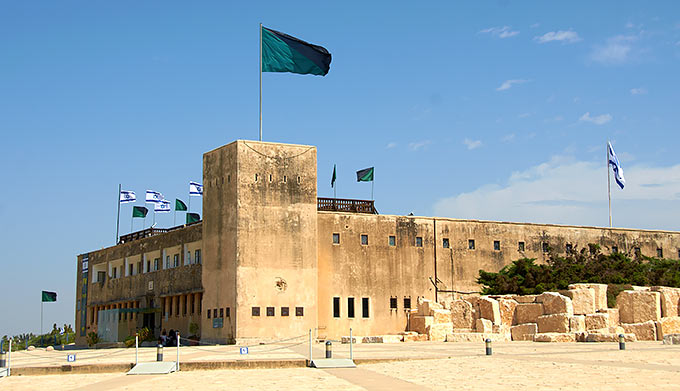
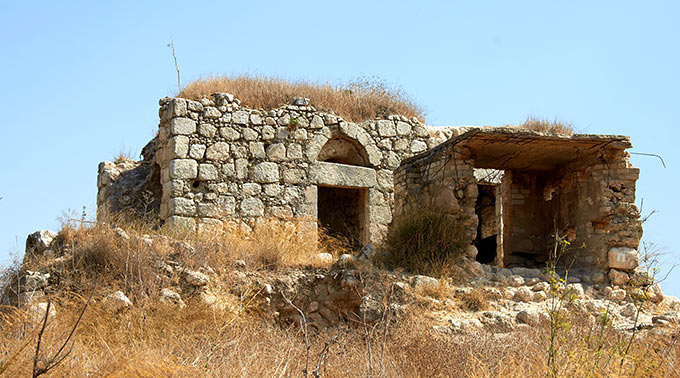
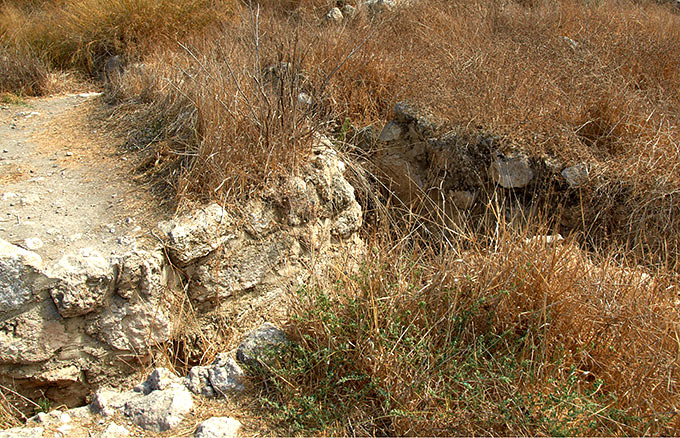 Trenches and machine-gun nest.
Trenches and machine-gun nest.